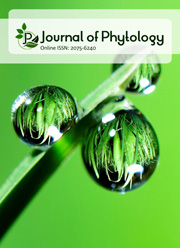Impact of electron beam and ethyl methane sulphonate on chlorophyll mutations in rice genotypes ASD 16 and Norungan
DOI:
https://doi.org/10.25081/jp.2024.v16.8866Keywords:
Rice, Chlorophyll mutations, Electron beam, EMS, Mutagenic effectiveness and efficiencyAbstract
Induced mutagenesis facilitates the creation of novel gene combinations within a plant genome, preserving its basic structure. This study investigates the impact of electron beam radiation and ethyl methane sulphonate (EMS) on chlorophyll mutations in rice genotypes, ASD 16 and Norungan. The seeds were irradiated with five different doses of electron beam and EMS during rabi 2021-22. The M1 generation was assessed for seedling survival, seedling height and spikelet fertility followed by an identification of chlorophyll mutants in the M2 generation. At specific mutagen doses, ASD 16 and Norungan exhibited the genotypic difference for chlorophyll mutants. Various chlorophyll mutations, such as albino, chlorina, xantha, striata, viridis, albomaculata, alboviridis and xanthoviridis were observed. ASD 16 was more sensitive to both mutagens, while Norungan showed a broader response. EMS proved to be a more effective in inducing mutations than the electron beam. Lower and moderate mutagen doses demonstrated higher efficiency indicating the importance of optimizing mutagenic conditions. This study illuminates the significance of chlorophyll mutants genetic makeup varietal differences. The strong and diverse response observed in Norungan underscores its suitability for mutation breeding programmes. These findings contribute to the efficient utilisation of mutagenesis in improving rice traits providing practical implications for elevating crop quality and promoting genetic diversity in rice cultivation.
Downloads
References
Awan, F. S., Sadia, B., Altaf, J., Habib, M., Hameed, K., & Hussain, S. (2021). Genetic variability through induced mutation. In R. T. Maia & M. de Araújo Campos (Eds.), Genetic variation London, UK: IntechOpen Limited. https://doi.org/10.5772/intechopen.95027
Benedict, C. R., & Ketring, D. L. (1972). Nuclear gene affecting greening in virescent peanut leaves. Plant Physiology, 49(6), 972-976. https://doi.org/10.1104/pp.49.6.972
Bordoloi, D., Sarma, D., Barua, N. S., & Das, B. K. (2023). Mutation induction in aromatic Joha rice of Assam for improvement of morpho-agronomic traits through M1 to M3 generation. International Journal of Radiation Biology, 99(11), 1760-1777. https://doi.org/10.1080/09553002.2023.2214197
Chakravarti, S. K., Singh, S., Ram, C. N., Vishwakarma, M. K., & Verma, G. S. (2017). Mutagenic effects of gamma rays and ems in M1 and M2 generations in two traditional genotypes of aromatic rice (Oryza sativa L.). International Journal of Agricultural & Statistical Sciences, 13(2), 537-543.
Das, T. R., Baisakh, B., & Prusti, A. M. (2021). Studies on mutagenic effectiveness and efficiency of gamma rays, ethyl methane sulfonate, nitrosoguanidine, maleic hydrazide and their combination in greengram (Vigna radiate L. Wilczek). International Journal of Current Microbiology and Applied Sciences, 10(1), 33543362. https://doi.org/10.20546/ijcmas.2021.1001.394
FAO/IAEAMVD. (2022). Joint FAO/IAEA Mutant Variety Database. Retrieved from https://mvd.iaea.org/
Gautam, V., Swaminathan, M., Akilan, M., Gurusamy, A., Suresh, M., Kaithamalai, B., & Joel, A. J. (2021). Early flowering, good grain quality mutants through gamma rays and EMS for enhancing per day productivity in rice (Oryza sativa L.). International Journal of Radiation Biology, 97(12), 1716-1730. https://doi.org/10.1080/09553002.2021.1987563
Goyal, S., Wani, M. R., Laskar, R. A., Raina, A., Amin, R., & Khan, S. (2019). Induction of morphological mutations and mutant phenotyping in black gram [Vigna mungo (L.) Hepper] using gamma rays and EMS. Vegetos, 32, 464-472. https://doi.org/10.1007/s42535-019-00057-w
Gustafsson, A. (1940). The mutation system of the chlorophyll apparatus. Sweden, England: C. W. K. Gleerup Publisher.
Hasib, K. M. (2022). Induction of chlorophyll and morphological mutations through gamma ray in traditional aromatic cultivar Tulaipanja. Biosciences Biotechnology Research Asia, 19 (3), 767-772.
Imam, Z., Chakraborty, N. R., & Gadi, J. (2019). Gamma ray induced effectiveness and efficiency of chlorophyll mutants in non basmati aromatic rice. Journal of Biotechnology and Crop Science, 8(12), 4-9.
Jadhav, A. H., Desai, S. S., Bhave, S. G., Mane, A. V., Sawardekar, S. V., Dalvi, V. V., & Bal, C. P. (2023). Optimization of LD50, frequency and spectrum of chlorophyll mutation, efficiency and effectiveness of gamma rays in different cultivars of rice (Oryza sativa L.). The Pharma Innovation Journal, 12(6), 4327-4333.
Konzak, C. F., Nilan, R. A., Wagner, J., & Foster, R. J. (1964). Efficient chemical mutagenesis. In The use of induced mutations in plant breeding (pp. 49-70) Report of the FAO/IAEA technical meeting, Rome, 1964). Oxford, UK: Pergamon Press.
Lalitha, R., Mothilal, A., Arunachalam, P., Vanniarajan, C., Senthil, N., Souframanien, J., & Hemalatha, G. (2020). Effectiveness and efficiency of gamma rays and electron beam in M2 generation of Anna (R) 4 rice mutants. Indian Journal of Agricultural Research, 54(4), 516-520. https://doi.org/10.18805/IJARe.A-5334
Li, F., Shimizu, A., Nishio, T., Tsutsumi, N., & Kato, H. (2019). Comparison and characterization of mutations induced by gamma ray and carbon ion irradiation in rice (Oryza sativa L.) using whole genome resequencing. G3: Genes, Genomes, Genetics, 9(11), 3743-3751. https://doi.org/10.1534/g3.119.400555
Naveena, N., Subramanian, S., Jawaharlal, M., Iyanar, K., & Chandrasekhar, C. N. (2020). Mutagenic effectiveness and efficiency of gamma rays and ethyl methane sulphonate on Hibiscus rosa-Sinensis L. Cultivar Red Single. Electronic Journal of Plant Breeding, 11(4), 1187-1193. https://doi.org/10.37992/2020.1104.191
Oladosu, Y., Rafii, M. Y., Abdullah, N., Hussin, G., Ramli, A., Rahim, H. A., Miah, G., & Usman, M. (2016). Principle and application of plant mutagenesis in crop improvement: a review. Biotechnology & Biotechnological Equipment, 30(1), 1-16. https://doi.org/10.1080/13102818.2015.1087333
Raina, A., Wani, M. R., Laskar, R. A., & Khan, S. (2022). Chemical mutagenesis: Role in breeding and biofortification of lentil (Lens culinaris Medik) mutant lines. Molecular Biology Reports, 49, 11313-11325. https://doi.org/10.1007/s11033-022-07678-6
SES, & IRRI. (2013). Standard evaluation system. Manila, Philippines: International Rice Research Institute.
Usharani, K. S., & Kumar, C. A. (2015). Mutagenic efficiency and effectiveness of gamma rays and EMS and their combination in inducing chlorophyll mutations in M2 generation of Urdbean (Vigna mungo (L.) Hepper). Electronic Journal of Plant Breeding, 6(1), 210-217.
Viana, V. E., Pegoraro, C., Busanello, C., & de Oliveira, A. C. (2019). Mutagenesis in rice: the basis for breeding a new super plant. Frontiers in Plant Science, 10, 1326. https://doi.org/10.3389/fpls.2019.01326
Vinithashri, G., Manonmani, S., Anand, G., Meena, S., Bhuvaneswari, K., & John Joel, A. (2020). Mutagenic effectiveness and efficiency of sodium azide in rice varieties. Electronic Journal of Plant Breeding, 11(1), 197-203.
Wani, M. R. (2018). Early maturing mutants of chickpea (Cicer arietinum) induced by chemical mutagens. Indian Journal of Agricultural Science, 88(4), 635-640. https://doi.org/10.56093/ijas.v88i4.79139
Published
How to Cite
Issue
Section
Copyright (c) 2024 M. Prasannakumari, R. P. Gnanamalar, C. Vanniarajan, J. Souframanien, G. Anand, R. Renuka, R. Durai Singh

This work is licensed under a Creative Commons Attribution 4.0 International License.





 .
.